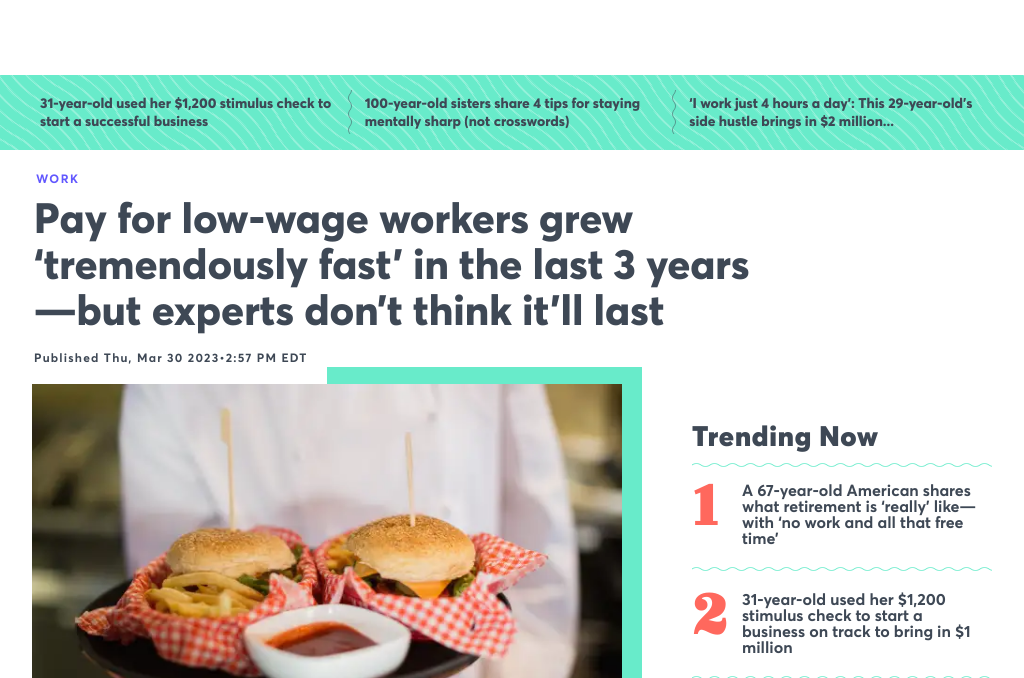Recent reports indicate that workers in the 10th percentile, those earning less than 90% of the population, have seen a significant increase in their wages.[0] According to research from the Economic Policy Institute (EPI), the real wages of these workers grew by 9% between 2019 and 2022, the biggest hike seen in decades. Adjusted for inflation, these workers earned $12.57 per hour or $26,145 annually in 2022.[1] This growth can be attributed to policies implemented in response to the COVID-19 pandemic and the tightening labor market from low unemployment, which gave workers increased leverage over their employers.[0]
These findings are significant, as the lowest-paid workers have not seen such real wage growth in the past 40 years, according to the EPI. However, while lower earners saw a 9% increase in their wages, the highest earners saw even greater gains. Wages for the top 1% and 0.1% increased by 16.1% and 29.2%, respectively, between 2019 and 2021, as per Social Security Administration data analyzed by the EPI.[2]
Despite this growth, there are concerns that the American job market may continue to face significant challenges due to the aging of baby boomers. Researchers at the Federal Reserve Bank of New York suggest that the primary cause of the current shortfall in the US labor force participation rate (LFPR) is demographic and other trends that existed before the pandemic. These trends include population aging and changes in education that influence people’s willingness to work. The LFPR currently stands at 62.5%, 0.8 percentage points below its level in February 2020, which translates to 2.1 million workers out of the labor force.[3]
While many sidelined workers were older and likely took early retirement, many prime-age workers, including millennials and Gen X, also exited the labor force.[4] The Bank of America Institute’s Understanding the Missing Millions study accounted for factors such as population aging and changes in education that influence people’s willingness to work. It showed that the US labor force participation rate was only about 0.3 percentage points below what it would have been without the pandemic, which translates to roughly 700,000 “missing” workers who would have been part of the workforce had it not been for pre-existing trends.[5]
In conclusion, while lower earners have seen a significant wage increase, the highest earners have also seen significant gains. However, there are concerns that the American job market may continue to face significant challenges due to the aging of baby boomers and pre-existing trends influencing people’s willingness to work.
0. “Wages for lowest earning workers increased drastically over the last three years” Washington Examiner, 23 Mar. 2023, https://www.washingtonexaminer.com/policy/economy/wages-lowest-earning-workers-increased-drastically-three-years
1. “Pay for low-wage workers grew ‘tremendously fast’ in the last 3 years—but experts don’t think it’ll last” CNBC, 30 Mar. 2023, https://www.cnbc.com/2023/03/30/low-wage-workers-saw-tremendously-fast-wage-growth-since-2019.html
2. “Pay soared for the lowest-wage workers from 2019-2022” Axios, 24 Mar. 2023, https://www.axios.com/2023/03/23/pay-soared-for-the-lowest-wage-workers-over-the-past-three-years
3. “What Has Driven the US Labor Force Participation Gap since February 2020?” Forex Factory, 30 Mar. 2023, https://www.forexfactory.com/news/1213425-what-has-driven-the-us-labor-force-participation
4. “Why Are Workers Sitting on the Sidelines? » CBIA” CBIA, 23 Mar. 2023, https://www.cbia.com/news/workforce/workers-sitting-sidelines/
5. “Where are all the missing workers? | HRD America” HRD America, 30 Mar. 2023, https://www.hcamag.com/us/specialization/recruitment/where-are-all-the-missing-workers/441301
